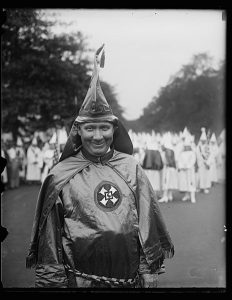TROUBLE FOLLOWS ME
Part Four
WHAT SEEMS TO BE THE TROUBLE?
It may seem an odd question, with the freshly dead corpse of a young girl swaying at the end of a rope in the Hawaiian night, but we quickly realize that this is not going to be a standard whodunnit. The body has just been discovered when racism dominates the action.

The national leader of the Klu Klux Klan at the outbreak of World War Two
BUT FIRST, LET’S TALK ABOUT MURDER NUMBER ONE
Macdonald is the last writer to show enthusiasm for the locked room murder, but the death of Sue Sholto is a good puzzle:
- She is found hanging from the window of the three interconnecting rooms that form the ladies lounge at Honolulu House. Coming in from the hallway at the top of the stairs is a large, well-lighted dressing room, with a washroom to one side. On the other side is a small, dark room with a couch. And the window.
- Sue Sholto is hanging from a noose formed by rope provided as a fire escape. One end is tied around the leg of a heavy sofa. Sholto’s fall had pulled the sofa as far as the wall, but it held there.
- Honolulu House was open for dinner and dancing and hundreds of people would have had access to the room.
- Prior to her death Sholto had argued with Eric Swann when he told her he was going back to his wife Helen in Detroit. Swann was on the grounds after the death, highly intoxicated.
- Although there was no note, the breakup with Swann could mean that the death was a suicide.
BUT ENOUGH OF THAT; LET’S GET TO THE REAL STORY
Even though he only appears in a few pages, the character who dominates the book is Hector Land, a black wardroom steward on Swann’s ship. The first time we meet him, it’s in passing; Hector is at Honolulu House, surrounded by a racist mob convinced that he not only murdered but also raped Sue Sholto.
“His ears were convoluted and frayed like black rosebuds after a hailstorm. His nose was broad and saddled, his eyes bright black slits between pads of dead tissue. It was an old boxer’s head, powerful and scarred as if it had once been used as a battering ram, set forward on a columnar neck as if it was ready to be used again. But there was no power in the posture of his body . . . He looked like a frightened bear caught in a dog pack.” It takes nothing more than a brief physical examination of Land and the body of Sholto to convince the coroner that no rape took place, and the mob disperses. But the tone of the book is set.
SO, WHO IS ON FIRST?
The book is narrated by Swann and the title suggests that trouble is following him. But the Drake of Trouble Follows Me is not the Branch of The Dark Tunnel. Swann is no fugitive. No one is hunting him. The person who trouble follows is Hector Land.
I acknowledge the insight of Peter Wolfe, from Dreamers Who Live Their Dreams:
“Land is a good bad man, whom Ross Macdonald neither patronizes nor uses as a peg on which to hang his views of racial injustice. But without intending to, he makes Land his main character. Drake’s ubiquity makes the book’s title a misnomer. Drake is not singled out for trouble or for bad luck . . . .”
CHAPTER THREE AND ALOHA
Macdonald has a lot of work to do, and it is a mark of his skill that the “take out the trash” function of the last chapter of Part I, the Oahu portion of the narrative, works so well. He seamlessly shovels in the following developments:
- Swann’s ship, with Hector aboard, is being sent to San Diego and then he will have leave to go home to Detroit. This means that although Drake will get there first (he has a clearance for air travel), the two of them can meet up later.
- It is discovered that Hector has been sending large amounts of money to his wife (who coincidentally also lives in Detroit). Hector explains the money as gambling winnings, which is an offense against Navy regulations.
- The coroner’s inquest on Sue Sholto’s death, hastily called because the Navy personnel are all being shipped out, returns a verdict of suicide, which Mary Thompson, her co-worker at the radio station, is reluctant to accept.
- After several dates full of unconvincing flirtation, Drake gets to first base with Mary Thompson, barely.
- Thompson announces that Sue’s death has ruined Hawaii for her and that she is returning to the States to her home in Cleveland. Which is not far from . . . . wait for it . . . Detroit.
Recent Comments